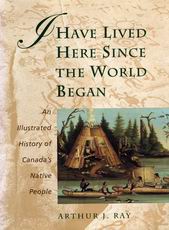
I Have Lived Here Since the World Began
An Illustrated History of Canada's Native People
Ray, Arthur J.
Publisher: Key Porter, Toronto, Canada
Year Published: 1996
Pages: 398pp Price: $45 ISBN: 1-895555-949
Library of Congress Number: E78.C2R38 1996 Dewey: 971'.00497
Resource Type: Book
Cx Number: CX6330
Ray shows that Native culture played an important -- and largely unrecognized -- part in Canada's economic development. Rather than being "civilized" by European explorers, the indigenous people were already accomplished traders, artisans, farmers and hunters.
Abstract:
Ray argues that Native culture played an important -- and largely unrecognized -- part in Canada's economic development. Rather than being "civilized" by European explorers, the indigenous people were already accomplished traders, artisans, farmers and hunters. Native culture began as the domain of anthropology and "salvage ethnologists," but it has gradually been included in Canadian history. However, modern histories of Native people are centred on ideological, religious, social and political aspects, leaving their economic history largely untold. It is this theme that Ray takes as his focus -- how Native people "took advantage of new economic developments or resisted those that offered them no benefit or degree of control."
Split into 20 chapters, the book is a chronological survey that begins just before first contact with European explorers and ends at the present day (1996). It begins with an account of indigenous people pre-contact, including rituals and spirituality, how identity was related to ancestral homelands and the influence of kinship on trading. Native legends of first contact suggest the need to reconsider European accounts of this experience. Native people took an active role in these encounters, and the trading networks they had established were subsequently taken over by Europeans. The growth of the fur trade saw a new kind of economic interaction between Europeans and Natives. The influx of European goods changed Native lifestyles, too. Multi-cultural societies sprang up around the new trading posts, most of which were owned by the Hudson's Bay Company.
But many conflicts developed because of trade and land. Natives tried, and often failed, to preserve their homelands by forming European or American alliances. Natives were frequently left out of decisions about their land, which resulted in protests like the Red River uprising and the North-West rebellion. Even greater efforts to assimilate Natives into the dominant white culture followed. In modern society, Natives are still fighting land claims in court and the process of reclaiming Native history from the dominant culture goes on. But non-Native Canadians are now redefining their concept of Canada. The more we understand about the past, the better equipped we'll be for the future. Includes a bibliography and index.
[Abstract by Alice Lawlor]
Table of Contents
Preface
Chapter 1: The Land as History Book
Chapter 2: The Cultural Mosaic
Chapter 3: Legends of the First Encounters
Chapter 4: Welcoming Newcomers
Chapter 5: New Friends and Foes
Chapter 6: Trade and War in the Western Interior
Chapter 7: Opportunities in the Fur Trade
Chapter 8: The Sea-Otter Bonanza
Chapter 9: Choosing Sides
Chapter 10: Fighting the Loyalists for Land
Chapter 11: The Changing Order in the Northwest
Chapter 12: Placed on a Little Spot
Chapter 13: The Metis and "Indian" Question
Chapter 14: Treaty Making
Chapter 15: It Is a Strict Law That Bids Us Dance
Chapter 16: From Buffalo Hunting to Farming
Chapter 17: The Modern Fur Trade
Chapter 18: Working for the Industrial Fishery
Chapter 19: Getting Organized
Chapter 20: Searching for Settlement
Selected Biography
Acknowledgement of Picture Sources
Index
Subject Headings


